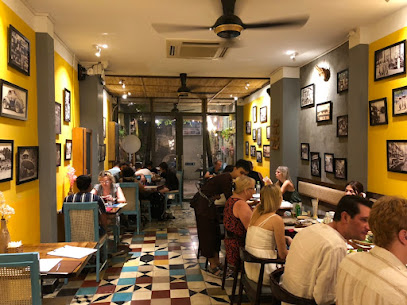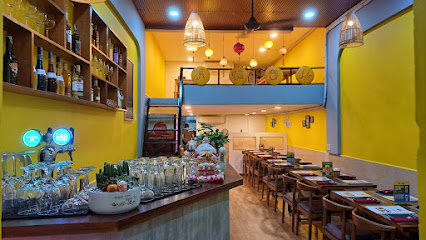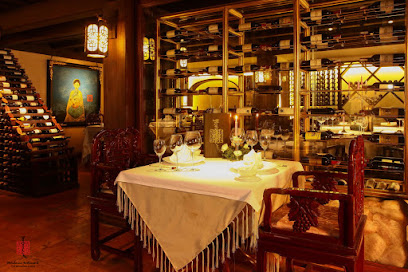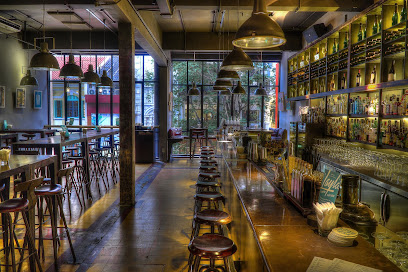
The Heartbeat of Ho Chi Minh City: District 1
Explore District 1 in Ho Chi Minh City: a vibrant mix of history, culture, shopping, and nightlife in Vietnam's bustling metropolis.
District 1 in Ho Chi Minh City is the vibrant epicenter of Vietnam's largest city. It is a bustling area where modern skyscrapers tower over colonial-era architecture and historic sites. This district offers a fascinating blend of the old and new, making it a must-visit spot for any traveler. Walking through District 1, you'll encounter famous landmarks such as the Notre-Dame Cathedral Basilica of Saigon and the Saigon Central Post Office, both stunning examples of French colonial architecture. For those interested in history, the War Remnants Museum provides a sobering look into Vietnam's past. The area is also a haven for shoppers and food enthusiasts. Ben Thanh Market is a bustling marketplace where you can find everything from local handicrafts to delicious street food. Nearby, the upscale shops and restaurants on Dong Khoi Street offer a more modern shopping and dining experience. Nightlife in District 1 is equally vibrant with rooftop bars, live music venues, and nightclubs that keep the city alive well into the early hours. Whether you're exploring its historical sites, indulging in its culinary delights, or enjoying its nightlife, District 1 offers a dynamic and unforgettable experience.
Local tips in District 1
- Visit Ben Thanh Market early in the morning to avoid the crowds and get the best deals.
- Wear comfortable shoes as you'll be doing a lot of walking, especially when exploring historical sites.
- Try local street food but ensure it is from a busy stall to ensure freshness and quality.
- Be cautious of your belongings in crowded areas to avoid pickpocketing.
- Use a trusted taxi service or ride-hailing app to navigate the city safely.
The Heartbeat of Ho Chi Minh City: District 1
District 1 in Ho Chi Minh City is the vibrant epicenter of Vietnam's largest city. It is a bustling area where modern skyscrapers tower over colonial-era architecture and historic sites. This district offers a fascinating blend of the old and new, making it a must-visit spot for any traveler. Walking through District 1, you'll encounter famous landmarks such as the Notre-Dame Cathedral Basilica of Saigon and the Saigon Central Post Office, both stunning examples of French colonial architecture. For those interested in history, the War Remnants Museum provides a sobering look into Vietnam's past. The area is also a haven for shoppers and food enthusiasts. Ben Thanh Market is a bustling marketplace where you can find everything from local handicrafts to delicious street food. Nearby, the upscale shops and restaurants on Dong Khoi Street offer a more modern shopping and dining experience. Nightlife in District 1 is equally vibrant with rooftop bars, live music venues, and nightclubs that keep the city alive well into the early hours. Whether you're exploring its historical sites, indulging in its culinary delights, or enjoying its nightlife, District 1 offers a dynamic and unforgettable experience.
Iconic landmarks you can’t miss
Ben Thanh Market
Explore the vibrant Ben Thanh Market, a cultural landmark in Ho Chi Minh City, for an authentic shopping and dining experience.

Independence Palace
Discover the historical significance and architectural beauty of Independence Palace, a key landmark in Ho Chi Minh City, Vietnam.

Bui Vien Walking Street
Experience the vibrant nightlife and rich culture at Bui Vien Walking Street, the heart of Ho Chi Minh City's entertainment and culinary scene.

Ho Chi Minh Statue
Explore the iconic Ho Chi Minh Statue, a symbol of Vietnam's rich history and cultural heritage, located in the heart of Ho Chi Minh City.

Tran Hung Dao Statue
Discover the Tran Hung Dao Statue in Ho Chi Minh City, a monumental tribute to Vietnam's heritage and resilience, surrounded by vibrant culture and history.

Di tích mộ cổ họ Lâm
Explore the rich history and cultural heritage at Di tích mộ cổ Lâm, a must-see historical landmark in the heart of Ho Chi Minh City.

Nguyễn Văn Hảo building
Explore the Nguyễn Văn Hảo Building in Ho Chi Minh City, a historical landmark that showcases Vietnam's rich cultural heritage and architectural beauty.

French Style Architecture Street
Explore the allure of French Style Architecture Street in Ho Chi Minh City, a captivating blend of history, culture, and stunning colonial architecture.

Former Norodom Palace
Discover the Former Norodom Palace, a stunning historical landmark in Ho Chi Minh City that reflects Vietnam's colonial past amidst vibrant urban life.

Mother Mary Statue
Discover the Mother Mary Statue in Ho Chi Minh City, a historical landmark combining faith, art, and serenity in the heart of bustling urban life.

Essential places to dine
Ngon Restaurant
Discover authentic Vietnamese flavors at Ngon Restaurant in Ho Chi Minh City—where culinary tradition meets modern dining.

Secret Garden Restaurant
Discover the serenity of Secret Garden Restaurant in Ho Chi Minh City—where authentic Vietnamese cuisine meets lush surroundings.

Propaganda Vietnamese Bistro
Experience authentic Vietnamese cuisine at Propaganda Bistro in Ho Chi Minh City - where tradition meets modern dining.

Home Saigon Restaurant
Experience authentic Vietnamese flavors at Home Saigon Restaurant in Ho Chi Minh City - where every dish tells a story.

Secret Garden, 131 Calmette Branch.
Experience authentic Vietnamese cuisine in a serene garden setting at Secret Garden, Ho Chi Minh City - your tranquil escape in the bustling city.

Chanh Bistro Rooftop Saigon
Experience exquisite Western cuisine with stunning skyline views at Chanh Bistro Rooftop Saigon – where every meal becomes a celebration.

A Taste Of Saigon
Discover authentic Vietnamese flavors at A Taste of Saigon, where every dish tells a story in the heart of Ho Chi Minh City.

Mandarine Restaurant
Experience the best of Vietnamese fine dining at Mandarine Restaurant in Ho Chi Minh City—where tradition meets elegance.

Square One
Experience exquisite French-Vietnamese fusion cuisine at Square One in Ho Chi Minh City—an unforgettable culinary delight awaits.

Hội An Sense Restaurant
Experience exquisite Vietnamese cuisine with stunning views at Hội An Sense Restaurant in Ho Chi Minh City.

Markets, malls and hidden boutiques
Takashimaya Ho Chi Minh City
Explore the luxury and diversity of Takashimaya Ho Chi Minh City, where shopping meets culinary delights in a vibrant atmosphere.

Saigon Centre
Discover shopping, dining, and entertainment at Saigon Centre, the premier shopping mall in the heart of Ho Chi Minh City.

Sense Market
Discover unique handmade crafts and local delicacies at Sense Market, Ho Chi Minh City's vibrant shopping haven.

The Craft House Original
Explore the heart of Ho Chi Minh City at The Craft House Original, where unique Vietnamese handicrafts and souvenirs await every traveler.

Mayhem Saigon Vintage Store
Explore the charm of vintage fashion at Mayhem Saigon, a unique store in Ho Chi Minh City offering curated clothing and local souvenirs.

Cửa Hàng Hòa Hoa - Saigon Kitsch
Explore the vibrant charm of Cửa Hàng Hòa Hoa, where authentic Vietnamese souvenirs and local craftsmanship come together in Ho Chi Minh City.

Cổ và Cũ
Discover unique Vietnamese gifts and souvenirs at Cổ và Cũ, a charming shop in the heart of Ho Chi Minh City, showcasing traditional craftsmanship.

Kito Shop
Discover a unique blend of fashion and culture at Kito Shop in Ho Chi Minh City, where every item tells a story.

Saigon Eco Craft
Experience the essence of Vietnam at Saigon Eco Craft, where unique handicrafts meet gourmet delights in the heart of Ho Chi Minh City.

coi gift shop
Discover the charm of Vietnam at Coi Gift Shop, where authentic souvenirs and local craftsmanship come together in the heart of Ho Chi Minh City.

Essential bars & hidden hideouts
Layla - Eatery & Bar
Experience the vibrant fusion of Australian cuisine and cocktails at Layla - Eatery & Bar in Ho Chi Minh City, a must-visit hotspot for food lovers.

The Alley Cocktail Bar & Kitchen
Experience the vibrant nightlife of Ho Chi Minh City at The Alley Cocktail Bar & Kitchen, where exquisite cocktails meet a chic atmosphere.

The Iron Bank - Cocktail Vault
Unwind in style at The Iron Bank - Cocktail Vault, where innovative cocktails meet a chic ambiance in the heart of Ho Chi Minh City.

Kim's Tavern
Experience the vibrant nightlife at Kim's Tavern, a top bar in Ho Chi Minh City known for its cocktails, entertainment, and welcoming atmosphere.

Loop 1 - Cocktail & Kitchen
Discover the vibrant nightlife at Loop 1 - Cocktail & Kitchen, your premier cocktail bar in Ho Chi Minh City, where creativity meets mixology.

Lost - Drink & Chill
Discover Lost - Drink & Chill, the ultimate cocktail bar in Ho Chi Minh City for unique drinks and a cozy atmosphere.

Above bar
Above Sky Bar offers stunning skyline views, signature cocktails, and vibrant nightlife in the heart of Ho Chi Minh City.

Snug Pub
Discover Ho Chi Minh City's nightlife at Snug Pub, where cocktails, live music, and a vibrant atmosphere await.

Bloom - Cocktail & Whisky Bar
Experience the vibrant nightlife of Ho Chi Minh City at Bloom Cocktail & Whisky Bar, where exquisite drinks and live music create unforgettable moments.

Cairo Lounge Bar Sai Gòn
Discover Cairo Lounge Bar Sai Gòn, a vibrant bar in Ho Chi Minh City offering exquisite cocktails and a lively atmosphere that captures the essence of nightlife.

Local Phrases
-
- HelloXin chào
[Sin chow] - GoodbyeTạm biệt
[Tahm byet] - YesCó
[Koh] - NoKhông
[Khom] - Please/You're welcomeLàm ơn
[Lam uhn] - Thank youCảm ơn
[Kahm uhn] - Excuse me/SorryXin lỗi
[Sin loy] - How are you?Bạn khỏe không?
[Ban kweh khom] - Fine. And you?Khỏe. Còn bạn?
[Kweh. Kawn ban] - Do you speak English?Bạn có nói tiếng Anh không?
[Ban koh noy tyeng ang khom] - I don't understandTôi không hiểu
[Toy khom hye-uh]
- HelloXin chào
-
- I'd like to see the menu, pleaseTôi muốn xem thực đơn, làm ơn
[Toy moon sem tuk dorn, lam uhn] - I don't eat meatTôi không ăn thịt
[Toy khom uhn tit] - Cheers!Chúc sức khỏe!
[Chuhk sook kweh] - I would like to pay, pleaseTôi muốn thanh toán, làm ơn
[Toy moon thanh to-an, lam uhn]
- I'd like to see the menu, pleaseTôi muốn xem thực đơn, làm ơn
-
- Help!Cứu!
[Kew] - Go away!Đi chỗ khác!
[De choh khak] - Call the Police!Gọi cảnh sát!
[Goi kahng saht] - Call a doctor!Gọi bác sĩ!
[Goi bahk si] - I'm lostTôi lạc đường
[Toy lahk doong] - I'm illTôi bị ốm
[Toy bee ohm]
- Help!Cứu!
-
- I'd like to buy...Tôi muốn mua...
[Toy moon mwa] - I'm just lookingTôi chỉ xem
[Toy chee sem] - How much is it?Nó giá bao nhiêu?
[Noh zah bao nyue] - That's too expensiveĐắt quá
[Daht kwah] - Can you lower the price?Bạn có thể giảm giá không?
[Ban koh te ziam zah khom]
- I'd like to buy...Tôi muốn mua...
-
- What time is it?Bây giờ là mấy giờ?
[Bay zoh la my zoh] - It's one o'clockBây giờ là một giờ
[Bay zoh la moht zoh] - Half past (10)Mười giờ nửa
[Moo-ee zoh noo-ah] - MorningBuổi sáng
[Buoy sahng] - AfternoonBuổi chiều
[Buoy chee-ew] - EveningBuổi tối
[Buoy toy] - YesterdayHôm qua
[Home kwa] - TodayHôm nay
[Home nai] - TomorrowNgày mai
[Nyai mai] - 1Một
[Moht] - 2Hai
[Hai] - 3Ba
[Ba] - 4Bốn
[Bon] - 5Năm
[Nam] - 6Sáu
[Sow] - 7Bảy
[Bye] - 8Tám
[Tahm] - 9Chín
[Cheen] - 10Mười
[Moo-ee]
- What time is it?Bây giờ là mấy giờ?
-
- Where's a/the...?Chỗ...ở đâu?
[Choh...uh doh] - What's the address?Địa chỉ là gì?
[Duh chee la zee] - Can you show me (on the map)?Bạn có thể chỉ cho tôi (trên bản đồ) không?
[Ban koh te chee chaw toy (trun bahn doh) khom] - When's the next (bus)?Khi nào là chuyến (xe buýt) tiếp theo?
[Khi now la chuyen (seh bwit) tyep theow] - A ticket (to ....)Vé (đi đến ....)
[Vay (dee den ....)]
- Where's a/the...?Chỗ...ở đâu?
History of District 1
-
District 1, known as the historical heart of Ho Chi Minh City, was originally established as a small fishing village named Prey Nokor in the 17th century. In the mid-19th century, during French colonial rule, the area underwent significant transformation. The French established Saigon as a major port city, leading to the construction of wide boulevards, grand colonial buildings, and public squares, which laid the foundation for District 1's urban landscape.
-
The architecture of District 1 showcases a blend of European and Vietnamese styles, with famous landmarks such as the Saigon Notre-Dame Basilica and the Saigon Central Post Office. These structures, built during the late 19th century, reflect the French influence on urban planning and architecture in Vietnam, symbolizing both the city's colonial past and its aspirations for modernity.
-
During the Vietnam War, District 1 was a focal point of both military and political activity. The area housed government offices, military headquarters, and the American embassy. The Tet Offensive in 1968 saw intense fighting in the district, marking a pivotal moment in the war. The aftermath of the conflict left a lasting impact on the city's landscape and society, with many historical sites bearing witness to this tumultuous period.
-
Following the reunification of Vietnam in 1975, District 1 emerged as a center for economic and cultural revival. The government's economic reforms in the 1980s, known as Đổi Mới, spurred significant development in the district, attracting foreign investment and revitalizing commerce. This era saw the rise of high-rise buildings, luxury hotels, and shopping centers, transforming District 1 into a vibrant hub of activity.
-
Today, District 1 is a dynamic blend of history and modernity. It is home to numerous cultural institutions, including the Saigon Opera House and the War Remnants Museum, which offer insights into the city's rich heritage. The district's bustling markets, street food, and nightlife reflect the vibrant culture of Ho Chi Minh City, making it a popular destination for both locals and tourists.
District 1 Essentials
-
District 1 is centrally located in Ho Chi Minh City and easily accessible from other neighborhoods. If you're arriving from Tan Son Nhat International Airport, take a taxi or book a ride-hailing service like Grab, which takes approximately 30 minutes depending on traffic. From District 2 or District 3, you can also use taxis or Grab, and public buses are available with routes that stop in District 1. The public bus can be an economical option, but be sure to check the schedules and routes.
-
District 1 is walkable and many attractions are within a short distance from each other. For longer distances, taxis and Grab are readily available. The Saigon Metro is also expanding, with a planned route through District 1, offering an alternative method of transport when operational. Bicycles can be rented from various shops or through bike-sharing services, providing a leisurely way to explore the area.
-
District 1 is generally safe for tourists, but standard precautions are advisable. Be cautious of your belongings in crowded areas, particularly around Ben Thanh Market and Bui Vien Street, which are known for petty theft. Avoid poorly lit streets at night and remain vigilant against scams targeting tourists. It’s advisable to stay in well-populated areas after dark.
-
In case of emergency, dial 113 for police assistance, 114 for fire, and 115 for medical emergencies. Hospitals such as FV Hospital and Vinmec International Hospital are located in District 1. It’s advisable to have travel insurance that covers emergencies. For minor health issues, pharmacies are widely available throughout the district.
-
Fashion: Do dress modestly, especially when visiting temples. Avoid overly revealing clothing. Religion: Do respect local customs; when visiting places of worship, dress conservatively and remove your shoes when required. Public Transport: Do be courteous and offer your seat to the elderly or pregnant women. Don’t eat or drink on buses or trains. Greetings: Do greet locals with a smile or a nod, and it’s polite to use 'Xin chào'. Eating & Drinking: Do try local food and beverages, and don’t hesitate to join locals for a meal. Don’t refuse food or drink offered to you, as it can be considered rude.
-
To experience District 1 like a local, visit the street food stalls and local markets where you can sample authentic Vietnamese dishes. Engage with local vendors and ask for their recommendations. Visit the Nguyen Hue Walking Street in the evenings for a vibrant atmosphere. For a unique experience, try a local coffee shop and order a traditional Vietnamese drip coffee. Don’t hesitate to explore hidden alleyways; they often lead to charming cafes and shops away from the tourist crowds.
Nearby Cities to District 1
-
Things To Do in Vung Tau
-
Things To Do in Can Tho
-
Things To Do in Phan Thiet
-
Things To Do in Mui Ne
-
Things To Do in Kratie
-
Things To Do in Phnom Penh
-
Things To Do in Dalat
-
Things To Do in Buon Ma Thuot
-
Things To Do in Kep
-
Things To Do in Kampot
-
Things To Do in Phu Quoc
-
Things To Do in Sihanoukville
-
Things To Do in Nha Trang
-
Things To Do in Koh Rong
-
Things To Do in Koh Kong











